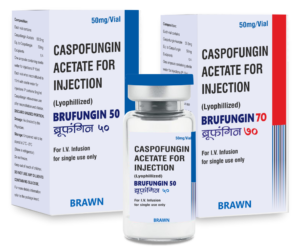
Introduction:
BRUFUNGIN 50mg/70mg (caspofungin acetate) is a sterile, lyophilized product for intravenous (IV) infusion that contains a semisynthetic lipopeptide (echinocandin) compound synthesized from a fermentation product of Glarealozoyensis.
BRUFUNGIN 50mg/70mg is a member of a class of antifungal drugs (echinocandins) that inhibits the synthesis of β (1, 3)-D-glucan, an integral component of the fungal cell wall. Caspofungin is a lipopeptide antifungal drug. It is a member of new class of antifungal termed as echinocandins. Caspofungin is antifungal agent with broad spectrum activity against all candida species.
Therapy Area: Antifungal
Form: Vial/Injection
Packaging: 1X1 Vial
COMPOSITION:Caspofungin 50 mg & 70 mg
MODE OF ACTION: Fungal cell has 2 components which work as protective barrier as follows
Fungal cell wall 2. Fungal cell membrane
Beta 1,3 glucan is main component of fungal cell wall. Fungal cell membrane or plasma membrane has an enzyme known as Beta Glucan Synthase which further helps in formation of Beta 1,3 Glucan. Beta 1,3 Glucan Further combines with Chitin (Fibrillar Polysaccharide) which increases strength of fungal cell wall.
Caspofungin block the synthesis of beta 1,3 glucan of the fungal cell wall by which cell deficiency takes place. Cell wall synthesis inhibits due to Caspofungin antifungal drug.
INDICATIONS
Dosage:
Loading dose of 70 mg on day 1 followed by maintenance dose of 50 mg once a day
Disclaimer:
This information is for registered medical practitioner only. Anyone other than medical practitioner should consult medical practitioner before using this product.
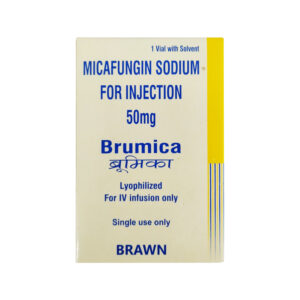
Introduction:
BRUMICA 50/100mg (Micafungin sodium) is a sterile, lyophilized intravenous (IV) infusion. Micafungin sodium is a semisynthetic lipopeptide (echinocandin) synthesized by a chemical modification of a fermentation product of Coleophoma empetri F-11899.
Micafungin inhibits the synthesis of 1, 3-β-D-glucan, an integral component of the fungal cell wall. Intravenous micafungin an echinocandin, is approved in the EU for the treatment of adult (aged ‡16 years) and paediatric patients with invasive candidiasis and for the treatment of adult patients with oesophageal candidiasis It does not require dose adjustments for renal or moderate hepatic dysfunction. It’s safety record, favorable tolerability profile, and few drug interactions make it an important agent for the treatment of invasive fungal infections
Therapy Area: Antifungal
Form: Vial injection
Packaging: 1×1 Vial
COMPOSITION: Micafungin Sodium 50 mg
Mode of Action: Micafungin, the active ingredient in BRUMICA, inhibits the synthesis of 1,3-β-D glucan, an essential component of fungal cell walls, which is not present in mammalian cells. Micafungin is a semisynthetic lipopeptide synthesized from a fermentation product of Coleophoma empetri that works as an antifungal agent. It is a glucan synthesis inhibitor of the echinocandin structural class.
INDICATIONS and DOSAGE
100 mg/day IV infusion x10-47 days (mean 15 days)
150 mg/day IV infusion x10-30 days (mean 15 days)
50 mg/day IV infusion x6-51 days (mean 19 days)
100 mg IV QD
Disclaimer:
This information is for registered medical practitioner only. Anyone other than medical practitioner should consult medical practitioner before using this product.
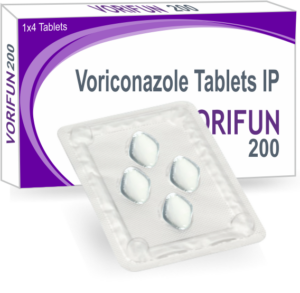
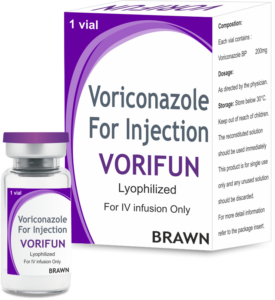
Introduction:
VORIFUN 200 mg Lyophilized Injection/Tablet(Voriconazole) is a triazole antifungal agent, is available as a lyophilized powder for solution for intravenous infusion, film-coated tablets for oral administration.
Therapy Area: Antifungal
Form: Vial Injection
Packaging: 1×1 Vial
Composition: Voriconacole 200 mg Injection/Tablet
Mode of Action: The mode of action of voriconazole is the inhibition of fungal cytochrome P450 mediated 14-alpha lanosterol demethylation, which causes damage in the structure and the loss of cell membrane function.Voriconazole is a broad spectrum antifungal agent indicated for the treatment of candidiasis also caused by fluconazole-resistant C. glabrata and C. krusei
Indications
Dosage:
6 mg/kg IV q12hr for first 24 hours,
Then 4 mg/kg IV q12hr or 200 mg PO q12hr
Disclaimer:
This information is for registered medical practitioner only. Anyone other than medical practitioner should consult medical practitioner before using this product.
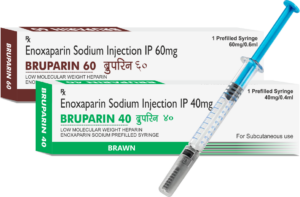
Introduction:
BRUPARIN- 40/60 mg Lyophilized Injection is an anticoagulant that helps to prevent the formation of blood clots. Enoxaparin is used to treat or prevent a type of blood clot called deep vein thrombosis (DVT), which can lead to blood clots in the lungs (pulmonary embolism).
A DVT can occur after certain types of surgery, or in people who are bed-ridden due to a prolonged illness.
Enoxaparin is also used to prevent blood vessel complications in people with certain types of angina (chest pain) or heart attack.
Enoxaparin was first made in 1981 and approved for medical use in 1993 and is derived from heparin.
Enoxaparin Sodium is the sodium salt of a low molecular weight heparin, obtained by alkaline depolymerisation of the benzyl ester of heparin sodium from porcine intestinal mucosa
Therapy Area: Medicine
Form: Injection
Packaging: 1 X 1 Ampoule
COMPOSITION: Enaxoparin 60 mg / Enaxoparin 40 mg
MODE OF ACTION: Enoxaparin is a type of low molecular weight heparin (LMWHs) with a mean molecular weight of 4000 to 5000.
It has an immediate onset of action when given in the intravenous form. It binds to and potentiates antithrombin III, a serine protease inhibitor, to form a complex that irreversibly inactivates factor Xa. The mechanism of action of enoxaparin is antithrombin-dependent.
It acts mainly by accelerating the rate of the neutralization of certain activated coagulation factors by antithrombin, Enoxaparin potentiates preferentially the inhibition of coagulation factors Xa and IIa
INDICATIONS
Dosage:
Treatment of DVT
Adult: 1 mg/kg every 12 hours
Pediatric < 2 months: 1.5 mg/kg sc every 12 hrs
2 months to 17 years: 1 mg/kg sc every 12 hrs
Unstable Angina and Non-Q-wave MI
1 mg/kg every 12 hours
Treatment of Acute STEMI
A single I.V. bolus of 30 mg plus a 1 mg/kg SC dose followed by a 1 mg/kg SC dose every 12 hours
Disclaimer:
This information is for registered medical practitioner only. Anyone other than medical practitioner should consult medical practitioner before using this product.
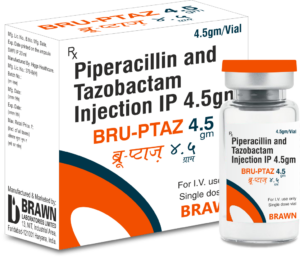
Introduction:
BRUP-TAZ Lyophilized Injection is an injectable combination of two antibiotics, piperacillin and tazobactam, with broad spectrum activity against an extended range of bacterial species. Piperacillin is an extended-spectrum penicillin antibiotic, but it can be destroyed by an enzyme produced by bacteria called beta lactamase. Tazobactam inhibits beta lactamase and prevents the destruction of piperacillin. Therefore, tazobactam is given with piperacillin to enhance the activity of piperacillin in eradicating bacterial infections. In-vitro studies of piperacillin and tazobactam have shown that the combination has activity against a variety of gram-positive and gram-negative aerobic and anaerobic bacteria.
Therapy Area: Antibiotic (Injectables)
Form: Parentral intravenous injection
Packaging: 1X1 Vial
COMPOSITION: Piperacillin Sodium 4gm + Tazobactum 500mg
MODE OF ACTION: Piperacillin kills bacteria by inhibiting the synthesis of bacterial cell walls. It binds preferentially to specific penicillin-binding proteins (PBPs) located inside bacterial cell walls.
Tazobactam broadens the spectrum of piperacillin by making them effective against organisms that express beta-lactamase and would normally degrade them. This occurs through the irreversible inhibition of beta-lactamase enzymes. In addition, tazobactam may bind covalently to plasmid-mediated and chromosome-mediated beta-lactamase enzymes. Tazobactam is predominantly effective against the OHIO-1, SHV-1, and TEM groups of beta-lactamases, but may also inhibit other beta-lactamases.
INDICATIONS
Dosage
Recommended Dosage: 4.5 g IV 6-8 hr; not to exceed 18 g/day
Disclaimer:
This information is for registered medical practitioner only. Anyone other than medical practitioner should consult medical practitioner before using this product.
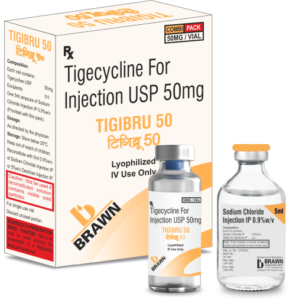
Introduction:
TIGIBRU Lyophilized Injection (Tigecycline) is the first clinically-available drug in a new class of antibiotics called the glycylcyclines. Glycylcyclines are a new class of antibiotics derived from tetracycline. These tetracycline analogues are specifically designed to overcome two common mechanisms of tetracycline resistance. Tigecycline injection is used to treat bacterial infections in many different parts of the body (eg, infections on the skin, stomach, or lungs). It works by killing bacteria or preventing their growth.
Therapy Area: Antibiotic (Injectable)
Form: Parentral intravenous injection
Packaging: 1×1 vial
COMPOSITION: Tigecycline 50mg
MODE OF ACTION:
Tigecycline, a glycylcycline, inhibits protein translation in bacteria by binding to the 30S ribosomal subunit and blocking entry of amino-acyl tRNA molecules into the A site of the ribosome. This prevents incorporation of amino acid residues into elongating peptide chains.
INDICATIONS & DOSAGE
Initial dose of 100 mg, followed by 50 mg every 12 hours
Initial dose of 100 mg, followed by 50 mg every 12 hours
Initial dose of 100 mg, followed by 50 mg every 12 hours
Children 8-11 years of age; Maximum 50 mg every 12 hours
Disclaimer:
This information is for registered medical practitioner only. Anyone other than medical practitioner should consult medical practitioner before using this product.
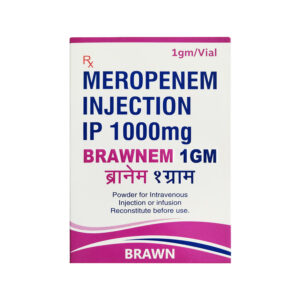
Introduction:
BRAWNEM Lyophilized Injection (Meropenem) is a broad-spectrum carbapenem antibiotic. It is active against Gram-positive and Gram-negative bacteria. Meropenem exerts its action by penetrating bacterial cells readily and interfering with the synthesis of vital cell wall components, which leads to cell death
Therapy Area: Antibiotic (Injectable)
Form: Parentral intravenous injection
Packaging: 1×1 vial
COMPOSITION: 1000 mg Injection
MODE OF ACTION:
The bactericidal activity of meropenem results from the inhibition of cell wall synthesis. Meropenem readily penetrates the cell wall of most Gram-positive and Gram-negative bacteria to reach penicillin-binding- protein (PBP) targets. Its strongest affinities are toward PBPs 2, 3 and 4 of Escherichia coli and Pseudomonas aeruginosa; and PBPs 1, 2 and 4 of Staphylococcus aureus.
INDICATIONS & DOSAGE
500mg IV q8hr; not to exceed 2 g IV q8hr
1g IV q8hr; not to exceed 2 g IV q8hr
2g IV q8hr
500mg IV q8hr for ≤5 days in combination with fluoroquinolone
1g IV q8hr
Disclaimer:
This information is for registered medical practitioner only. Anyone other than medical practitioner should consult medical practitioner before using this product.
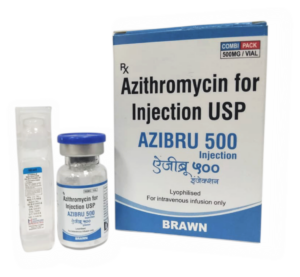
Introduction:
Azithromycin is a broad-spectrum macrolide antibiotic with a long half-life and a high degree of tissue penetration. It was initially approved by the FDA in 1991
Azithromycin is a part of the azalide subclass of macrolides, and contains a 15-membered ring, with a methyl-substituted nitrogen instead of a carbonyl group at the 9a position on the aglycone ring, which allows for the prevention of its metabolism. This differentiates azithromycin from other types of macrolides
Therapy Area: Antibiotic (Injectable)
Form: Parentral intravenous injection
Packaging: 1×1 vial
COMPOSITION: Azithromycin 500 mg Injection
MODE OF ACTION:
Azithromycin binds to the 23S rRNA of the bacterial 50S ribosomal subunit. It stops bacterial protein synthesis by inhibiting the transpeptidation/translocation step of protein synthesis and by inhibiting the assembly of the 50S ribosomal subunit. This results in the control of various bacterial infections
Azithromycin is highly stable at a low pH, giving it a longer serum half-life and increasing its concentrations in tissues compared to erythromycin
INDICATIONS & DOSAGE
Cervicitis| Salpingitis| Endometritis| Peritonitis
Dosage: 500mg IV as a single daily dose by IV route followed by 250 mg to
Complete a 7 day course of therapy
Dosage: 500 mg IV X 1 dose on Day 1, Followed by 250 mg IV qDay on Days 2-5
Disclaimer:
This information is for registered medical practitioner only. Anyone other than medical practitioner should consult medical practitioner before using this product.
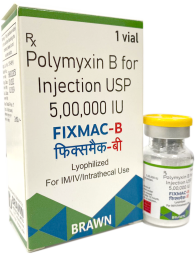
Introduction:
FIXMAC-B(Polymyxin B) is an antibiotic that disrupts the outer cell membrane of Gram negative bacteria, binds and neutralizes lipopolysaccharide, and inhibits respiration of Gram-negative bacterial cells4. Polymyxin B can be given by a number of routes to treat susceptible Gram negative bacterial infections. Absorption of the drug is poor and the excreted drug is unchanged by metabolic processes. Polymyxin B is generally indicated for susceptible Gram negative infections of the urinary tract, meninges, and bloodstream Label.
Therapy Area: Antibiotic (Injectable)
Form: Parentral intravenous injection
Packaging: 1×1 vial
COMPOSITION: POLYMIXIN B SULPHATE 500000 IU Injection
MODE OF ACTION:
Polymyxin is active against common Gram negative bacteria but not Gram negative cocci, Gram positive bacteria, or anaerobic bacteria
Polymyxins interact with lipopolysaccharide (LPS) of the outer membrane of Gram-negative bacteria and is subsequently taken up via the ‘self-promoted uptake’ pathway
INDICATIONS
Dosage
IV(Intravenous)
Dissolve 500,000 polymyxin B (polymyxin b sulfate) units in 300 to 500 ml solutions.
IM(Intramuscular)
Dissolve 500,000 polymyxin B units in 2 mL sterile water for injection
IT(Intrathecal)
Dissolve 500,000 polymyxin B(polymyxin b sulfate) units in 10 mL sodium chloride injection USP
Disclaimer:
This information is for registered medical practitioner only. Anyone other than medical practitioner should consult medical practitioner before using this product.
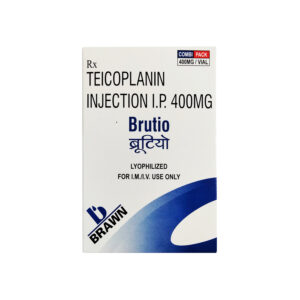
Introduction:
BRUTIO(Teicoplanin) is a glycopeptide antibiotic
Teicoplanin inhibits the growth of susceptible organisms by interfering with cell wall biosynthesis hence, is bactericidal; It is active against staphylococci (including those resistant to methicillin and other βlactam antibiotics), streptococci, enterococci, Listeria monocytogenes, corynebacteria and gram-positive anaerobes including Clostridium difficile and peptococci
Teicoplanin is similar to vancomycin, but has a significantly longer duration of action, allowing once daily administration after the loading doses
Therapy Area: Antibiotic (Injectable)
Form: Parentral intravenous injection
Packaging: 1×1 vial
COMPOSITION: POLYMIXIN B SULPHATE 500000 IU Injection
MODE OF ACTION:
Teicoplanin inhibits peptidoglycan polymerization, resulting in inhibition of bacterial cell wall synthesis and cell death.
It is a glycopeptide antiobiotic extracted from Actinoplanes teichomyceticus, with a similar spectrum of activity to vancomycin
Indications & Dosage
Loading Dose: 400 mg IV or IM every 12 hours for three administrations
Maintenance Dose: 6mg/kg body weight IV or IM once a day
Loading Dose: 800 mg IV every 12 hours for three to five administrations
Maintenance Dose: 12 mg/kg body weight IV or IM once a day
Disclaimer:
This information is for registered medical practitioner only. Anyone other than medical practitioner should consult medical practitioner before using this product.
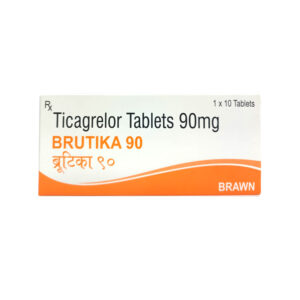
Introduction:
BRUTIKA (Ticagrelor) is used to prevent a serious or life-threatening heart attack or stroke, or death in people who have had a heart attack or who have Acute coronary syndrome (ACS; blockage of blood flow to the heart).
Ticagrelor is used to decrease the risk of a first-time heart attack or stroke in people at risk with coronary artery disease (CAD; reduced blood flow to the heart).
Therapy Area: Antibiotic
Form: Tablets
Packaging: 1X10’s
COMPOSITION: Ticagrelor 90mg Tablets
Mode of Action: Ticagrelor is an orally administered direct-acting Platelet P2Y12-receptor antagonist.
In vitro studies have demonstrated that ticagrelor binds reversibly and noncompetitively to the P2Y12 receptor at a site distinct from that of the endogenous agonist adenosine diphosphate (ADP)
The platelet P2Y12 receptor (P2Y12R) for adenosine 5’diphosphate (ADP) plays a central role in platelet function, hemostasis, and thrombosis
Indications:
Stroke|Myocardial Infarction|Acute Coronary Syndrome
Dosage:
180mg loading dose followed by maintenance dosage of 90mg twice daily during the first year;
After first year, maintenance dosage of 60mg twice daily is recommended
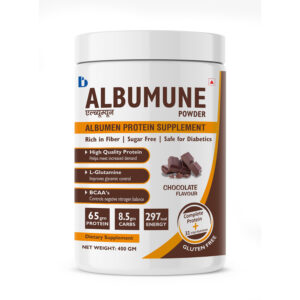
Introduction:
Albumen also known as egg whites; It is the clear, thick liquid that surrounds the bright yellow yolk of an egg; The majority of egg albumen is water, which ranges approximately from 84% to 89%
Proteins constitute the major portion (10%–11%) of albumen primarily
Other components, such as carbohydrates, lipids, and minerals, form a minor portion of albumen
They are high in protein yet low in calories, fat, and cholesterol
Good source of supplement for those patients having high protein requirements but need low calorie intake
Therapy Area: Nutritional Supplement
Form: Protein Powder
Packaging: 400 GM
COMPOSITION: Albumen Protein Supplement 400 gm Powder
Mode of Action:
Albumen 65%
Controls hypoalbuminemia effectively
Lycopene 10%
Poweful antioxidant; reduces the risk of cancer & cardiovascular disorders
BCAAs
Helps increase muscle growth
L-arginine & L-arginine
Building blocks of protein, helps in glycemic & BP control
Multivitamins & Multiminerals
Reduces inadequacies in micronutrient intake
Indications
Dosage
2 levels scoop ( 30 gm = 2*15 gm )
2 times a day or as recommended by medical practitioner